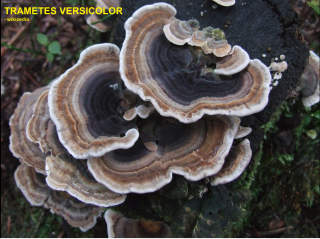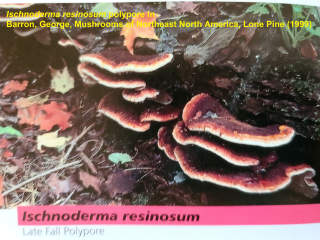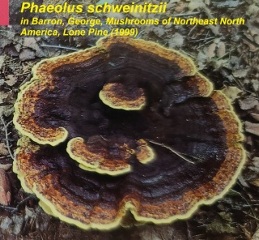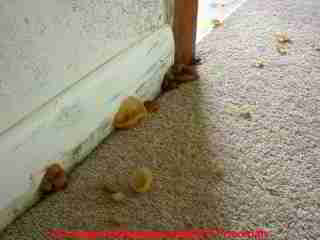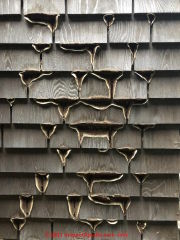 Fungus or Mold on Wood Exteriors
Fungus or Mold on Wood Exteriors
How to remove & prevent algae, fungus, lichens, mold growth on shingles, clapboards, trim
- POST a QUESTION or COMMENT about removing & preventing mold growth on wood shingles, clapboards, trim, decks, etc.
This article describes the cause, cure & prevention of mold and fungal growth on wood building materials outdoors.
Our page top photo, courtesy of InspectApedia.com reader Judy, shows extensive fungal growth on wood shingle siding.
InspectAPedia tolerates no conflicts of interest. We have no relationship with advertisers, products, or services discussed at this website.
- Daniel Friedman, Publisher/Editor/Author - See WHO ARE WE?
Clean off Moldy Siding, Trim, Decks & Prevent Recurrence
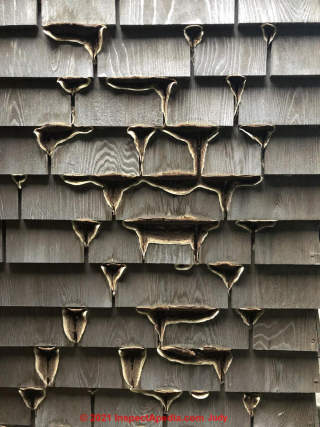 Here we discuss the pros and cons of cleaning methods to get rid of this unsightly fungus, options for preventing or controlling its re-appearance, and we explain the need for further investigation for hidden mold & water damage.
Here we discuss the pros and cons of cleaning methods to get rid of this unsightly fungus, options for preventing or controlling its re-appearance, and we explain the need for further investigation for hidden mold & water damage.
Reader Question:
This fungus is growing on my shingle house near the ocean. What is it and how do I control it? - Judy, 2021/12/05
This question was posted originally
at ALGAE, FUNGUS, LICHENS, MOSS COMPARED
Moderator reply: steps to assess, remove, & prevent fungal growth on wood siding
@Judy,
That looks like a wood-rot fungus, perhaps a polypore or (less likely) a bracket fungus - a group that only grows on wood. These are wood-rotting fungi.
What we are seeing in your photo of fungus growing on wood siding (is that pine not cedar?) is the fruiting body of a fungus. That means, in part, that there is probably additional fungal growth (the mycelia or "roots" so to speak) that is not visible but is behind your wood siding.
One of the challenges in identifying fungi to a specific genera/species is that what the fruiting body looks like growing in nature may be rather different than what it looks like growing on a building material whose consistency and shape and other features provide somewhat different food to the fungus.
But what your wood siding fungus looks most like is a polypore or less-likely a bracket fungus of which I find in our mushroom guides (National Audubon Society "Field Guide to Mushrooms" and Lone Pine's "Field Guide to Mushrooms of Northeast America" several fungi that resemble yours but of course are growing on trees not on wood shingle siding.
Happily knowing the fungal genera and species is not necessary to decide what to do about it: the genera/species of mold or fungi on buildings does not change the treatment needed:
- find all the mold,
- remove it, and
- fix its cause.
Below: Trametes versicolor or "Turkey Tail" as illustrated at Wikipedia and then Thelephora terrestris as illustrated in Barron, George, Mushrooms of Northeast North America, Lone Pine (1999).
Trametes versicolor – also known as Coriolus versicolor and Polyporus versicolor – is a common polypore mushroom found throughout the world. Meaning 'of several colors', versicolor reliably describes this fungus that displays different colors. - 2021/12/05 - original source: https://en.wikipedia.org/wiki/Trametes_versicolor
and Phaeolus schweinitzii in Barron, George, Mushrooms of Northeast North America, Lone Pine (1999)
Below: Thelephora terrestris or "Earth Fan" fruiting body
Below: Ischnoderma resinosum polypore
Ischnoderma resinosum polypore in Barron, George, Mushrooms of Northeast North America, Lone Pine (1999)
and Phaeolus schweinitzii, another polypore from the same text.
Cleaning Fungal Growth & Mold Growth on Siding: Introduction
In my opinion this fungal growth is difficult to treat, and fruitless to treat without adequate cleaning, and probably not a durable treatment without following cleaning by treatment to repel water and mold growth in the future.
I’ll follow with details in a couple of posts as what I have to say is too long for our Comment Box to handle.
- Mechanical cleaning of fungus on siding:
Trying to mechanically remove the visible fruiting body parts by gentle scraping, if you do not work with great care, is going to gouge up the wood siding and regardless of the level of care, because you are only cleaning the exposed surface of your wall, the process is going to leave the fungal mycelia that will produce more fungal growth, and without further inspection it also risks leaving rot in the wood sheathing behind the siding
That hidden damage may be severe, yet un-discovered, and worse still depending on how much water has leaked into the wall and exacrbated if there isn't a weatherproof waterproof housewrap. - Spraying with a fungicide combined with a deck/siding cleaner:
Spraying gently on the surface might kill back the fungus for a time but without taking a mechanical-removal step that leaves unsightly fruiting body growth on the walls and may not reach the mycelia behind the siding.
And sprays may discolor the siding. For this reason and for the actual fungal body growth shown in your photo we suggest mechanical cleaning first, and spray cleaning second. - Spray-cleaning with a power washer? No.
Watch out: this aggressive approach might remove a lot of the fruiting bodies from the wall but unless done in the hands of an expert will leave sprayer cuts into the soft pine (not cedar?) shingles, permanently disfiguring it.
Worse, if a heavy-handed or careless worker sprays "UP" with the power sprayer that drives water or siding or deck cleaner into the wall behind the siding, risking further water damage to the building.
See our warnings
at POWER WASHING ROOFS - Fungus & Mold Control
Watch out: none of the cleaning options I list above for removing fungal growth from wood shingle siding will "control" (as you put it) the fungus growth long-term because we have not addressed the underlying cause of its growth. So additional steps, at the least, treatment of the wood siding, are in order.
In addition if an inspection of the building finds leaks behind siding there are more-serious, costly, and extensive corrections needed, such as installing flashing, housewrap under new siding, or use of sealants.
Watch out: Without a careful onsite inspection and knowing more about the building construction, actual location and thus climate, and about the conditions of the wall cavity and the siding material, a shoot-from-the-hip prescription for preventing future fungal growth on your siding is just that - wild mold-bullets poorly aimed.
Fungus / Mold On Siding: Cleaning Procedures
- Investigate hidden building areas & cavities first
Watch out: when you see a fungal fruiting body on any building surface you’re seeing the tip of a fungal iceberg. The fruiting body that you see is produced by the actual “real” body of the fungus, its mycelia or “root structure” in lay terms, that you can not see as it’s behind the wood shingles (in your case) or in nature, in the ground or in the case of polypores or shelf fungi who attack wood, under the bark of the tree. The mold’s real bite is hidden by the moldy bark.
For this reason it is a poor strategy to attack your siding's fungal infection before we know what steps are actually needed to protect your home and its occupants from mold and fungal growth.
Visual Inspection of Related Building Areas
Before moving to destructive inspecting (below) a visual inspection inside at the wall bottom for mold, dampness (use a moisture meter) and if there’s a basement or crawl area a visual inspection of the lower areas of the wall there can give an advance warning about the risk of serious in-wall fungus, mold or water.
Destructive inspecting a wall for water and fungal or mold damage
Remove a few shingles at wall bottom in a fungus-grown-over-area outside and cut a small test cut at wall bottom inside to inspect the wall cavity. A 2” x 4” hole is sufficient to inspect the wall cavity. Always make destructive test cuts first into the “most-suspect” area of wall damage.
If you find wet insulation, moldy drywall, water in wall cavities, then it is throwing good money after bad to simply work on a cosmetic “band-aid” approach by cleaning the exterior.
If you do NOT find wall cavity problems, the hurrah! we can move on to treating just the exterior of the siding, with this warning:
- Determine the ease of fungus or mold removal
For a fruiting body fungal growth like that shown in your photo I would test mechanical scraping to see if the fungus can be easily-removed.
For the more-common mold growth patterns on wood in which the mold appears in spores and tiny fruiting bodies, scraping isn't appropriate. Gentle spraying, careful use of a soft bristle brush, can work.
Aggressive media blasting methods are not appropriate for wood siding as that causes too much damage.
Test Scraping: Starting at an unobtrusive location on your exterior wall, try gentle scraping upwards with a 3” or 4” plastic or steel drywall knife, taking care to minimize gouging of the shingles. You won’t be able to remove the fungal growth that is behind the wood shingles and you really can’t remove the fungal growth between them without, I expect, too much damage to the shingles.
If this particular polypore or shelf fungus is mostly removed but there is some debris left on the shingle surface you can try gentle brushing “down” or with the wood grain, scrubbing softly using your cleaning liquid (detailed in step 2).
- Remove the fungal bodies or mold
IF you ARE ABLE to remove the fungal growth: mechanically (with a scraper) clean off the bulk of the fruiting body, following up with a liquid and gentle spray-on cleaning product, followed by rinsing thoroughly and letting the siding dry followed by a preservative and water-resistive penetrating stain will cover up the worst of your gouges and will improve the walls’s resistance to mold and fungal growth.
then try gentle spray cleaning with products sold to clean mold or fungus or algae from wood siding after first identifying the wood species of your singles to be sure the product you choose is compatible.
IF you ARE NOT ABLE to remove the fruiting body of this fungus then in my view trying to kill it and leave it in lace is a poor approach and you are likely to have to remove the siding, inspect, clean, repair and housewrap the wall behind it, install new siding and treat it as described below.
- Follow physical removal of mold or fungus contamination with a deck or siding cleaner.
I and others interested in this problem usually use a wood-deck cleaner product like Wolman’s DeckBrite.
SimpleGreen (simplegreen.com) recommends their product prepared by mixing 1 ½ cups of Simple Green Oxy Solve House and Siding Cleaner in a gallon of water and spraying that onto the siding with a simple garden hose sprayer - an approach I approve as the spray is gentle enough not to cut into the wood shingles.
Watch out: never spray “up” onto wood shingle or wood clapboard siding or you risk driving so much water behind the siding that you cause hidden damage such as leaks into the wall cavity, wet insulation, and you invite mold contamination, rot, and insect damage.
Watch out: USDA in some articles recommends bleach which I caution you risks horrible siding discoloration if it's not sprayed in the right order and rinsed very thoroughly.
Other experts recommend a wood shingle cleaning solution that combines bleach with TSP (Trisodium phosphate). TSP is legal and sold in some jurisdictions and is an effective cleaner when used properly, but it is also banned as an environmental contaminant in some communities.
If you are going to try bleach, use an oxygen-based bleach (powder dissolved in water) not typical chlorine-based laundry bleach.
Steps to Prevent Fungal Growth on Wood Shingle Siding
- Treat the wood siding to repel algae, lichens, mold & water
When the wood siding is clean and dry, using any preservative penetrating wood stain will help by repelling moisture.
Some of these products like Defy wood stain we’ll describe below use a synthetic resin base that may be longer lasting than more-typical penetrating wood preservative stains. (Don’t even think about a non-penetrating stain nor paint on wood shingle siding regardless of the wood species. )
The folks over at Buffalo Lumber have their own opinion about choice of products to clean and prevent mold growth on cedar siding that might work also on pine, “How to Remove Cedar Mold from Wood Siding” (no author named), original source: https://www.buffalo-lumber.com/lumber-articles/how-to-remove-cedar-mold-from-wood-siding/
That author likes Defy wood treatments.
The Defy, a line of wood cleaning and treatment products from SaverSystems, provides at least three products of which the last would be my recommendation: Defy wood cleaner (for cleaning wood decks or siding), Defy water repellent (for improving water resistance that you’d think would help your wood shingle covered walls but I’m doubtful), and Defy Extreme Wood Stain that combines a penetrating stain with a water repellant and perhaps a fungicide.
I couldn’t find detailed product use instructions (other than videos) nor durability studies at the company’s website but we include some research below.
Wood Siding Cleaners & Preservative Stains for Mold/Fungus Prevention
- Nisus, BORA-CARE REMEDIAL PROTOCOLS (insect & fungal treatment) Disodium Octaborate Tetrahydrate (Borate) 40%, Website: https://nisuscorp.com/product/bora-care
Website excerpt:
Bora-Care® Termiticide, Insecticide and Fungicide Concentrate is a wood treatment with patented glycol penetrants that kills and prevents termites, carpenter ants, wood boring beetles and decay fungi.
Used as a replacement for soil treatments in new construction and serves as a primary termite treatment on the HUD-99-A form.
Also used to kill and prevent termites and wood boring beetles in existing construction. - DEFY EXTREME WOOD STAIN Product Data Sheet [PDF] available SaverSystems Richmond, IN 47374 800-860-6327 Fax: 765-935-4999 www.defywoodstain.com,
- DEFY EXTREME SEMI-TRANSPARENT WOOD STAIN MSDS [PDF] Op Cit. for a better understanding of how to use the product and its ingredients
- PAINT & STAIN GUIDE, EXTERIOR - our own guide
- Simple Green HOW TO CLEAN WOOD SIDING [PDF] Simple Green, retrieved 2021/12/05 original source: https://simplegreen.com/cleaning-tips/rooms/outdoors/wood-siding/
- Wash Safe Industries, CEDAR WASH Organic Wood Cleaner (hydrogen peroxide) Website: Washsafe.com Tel: 888-908-9274
Research on Preventing Mold on Wood Shingles, Clapboards, Exterior Trim
- Dwyer, Jack, Tony Bonura, Arnie Nebelsick, Sam Williams, and Christopher G. Hunt. INSTALLATION, CARE, AND MAINTENANCE OF WOOD SHAKE AND SHINGLE SIDING [PDF] (2011) General technical report FPL-GTR-202. Madison, WI: US Dept. of Agriculture, Forest Service, Forest Products Laboratory, 2011: 13 p. (2011).
Description:
This article gives general guidelines for selection, installation, finishing, and maintenance of wood shakes and shingles. The authors gathered information from a variety of sources: research publications on wood finishing, technical data sheets from paint manufacturers, installation instructions for shake and shingle siding, and interviews with experts having experience constructing and inspecting shake and shingle siding.
If research reports could not be found, the recommendations are based on opinions of experts and practices that have been shown to give good service life for shakes and shingles. More detailed information is available from shake and shingle suppliers, paint manufacturers, and the Cedar Shake and Shingle Bureau (CSSB).
Watch out: the following statement found in this article is incomplete, in particular for wood species other than cedar that are more-vulnerable to wood-rotting fungii. The authors are focused on cedar that is naturally rot resistant. But a number of wood-rotting fungi will attack pine and other wood species including white pine, southern yellow pine, or oak shingles and clapboards.
As wood ages, mildew (mold) and algae begin to grow on the surface. This is a normal process and these organisms do not degrade the wood; they cannot break down the structural components of wood. Although they can metabolize extractives in wood, they primarily feed off airborne contaminants. Because they do not attack the wood, removing them is a cosmetic issue: ignoring them will not damage the wood. - Morrell, J., J. Cappellazzi and J.W. Pscheidt, CARE AND MAINTENANCE OF WOOD SHINGLE AND SHAKE ROOFS [PDF] (2020) Oregon State University Ectension, PNW Pacific Nothwest Extension Publishing, PNW 733 retrieved 2021/12/05 original source: https://catalog.extension.oregonstate.edu/sites/catalog/files/project/pdf/pnw733.pdf
- Niemiec, Stanley S., and Terence D. Brown. "Care and maintenance of wood shingle and shake roofs." (1988). (Obsolete, see Morrell et als 2020)
- Williams, R. Sam. Water repellents and water-repellent preservatives for wood. Vol. 109. Forest Products Laboratory, 1999.
- Wise, Madelon, MAINTENANCE OF CEDAR SIDING: REMOVAL OF ALGAE, MOLD, AND IRON STAINS [PDF] (2014) USDA, USFPL, original source: fpl.fs.fed.us/labnotes/
Mushrooms or Mold Fruiting Bodies Also Grow on Indoor Wood
Just for the record, "mushrooms" or the fruiting bodies of some fungal species are found growing on both outdoor and some indoor surfaces including carpet and wood trim, as shown in the photo below. We also find mushdrooms or fungal fruiting bodies growing on dirt floors in basements or crawl spaces.
The indoor fungi grrowing on carpet and wood trim are discussed
at RENTAL UNIT MOLD & IAQ FAQs
Also see BROWN HAIRY BATHROOM MOLD for a Q&A on the harmfulness of "hairy brown mold" found in a bathroom.
...
Continue reading at MOLD CLEANUP - WOOD FRAMING & PLYWOOD, or select a topic from the closely-related articles below, or see the complete ARTICLE INDEX.
Or see these
Recommended Articles
- ALGAE & MOLD STAINS on EXTERIORS
- BLACK or GREEN ALGAE STAIN REMOVE / PREVENT
- CISTERNS, WATER STORAGE - plastic water tank colour affects algae growth
- MILDEW REMOVAL & PREVENTION
- MOLD APPEARANCE - STUFF THAT IS NOT MOLD
- MOLD APPEARANCE: WHAT MOLD LOOKS LIKE on building surfaces
- MOLD in BUILDINGS for a guide to looking for mold contamination in or on buildings
- MOLD CLEANERS - WHAT TO USE
- MOLD CLEANUP - WOOD FRAMING & PLYWOOD
- PAINT & STAIN GUIDE, EXTERIOR
- PAINT & STAIN SELECTION & PROCEDURES
- STAINS on & in BUILDINGS, CAUSES & CURES - topic home
- STONE, STUCCO & BRICK CLEANING METHODS
- STUFF MISTAKEN FOR MOLD - harmless substances that people think are toxic mold
- TRAPPED MOLD BETWEEN WOOD SURFACES
Suggested citation for this web page
MOLD & FUNGUS on WOOD SIDING: CLEAN & PREVENT at InspectApedia.com - online encyclopedia of building & environmental inspection, testing, diagnosis, repair, & problem prevention advice.
Or see this
INDEX to RELATED ARTICLES: ARTICLE INDEX to BUILDING STAINS
Or use the SEARCH BOX found below to Ask a Question or Search InspectApedia
Or see this
INDEX to RELATED ARTICLES: ARTICLE INDEX to MOLD CONTAMINATION & REMEDIATION
Or use the SEARCH BOX found below to Ask a Question or Search InspectApedia
Ask a Question or Search InspectApedia
Try the search box just below, or if you prefer, post a question or comment in the Comments box below and we will respond promptly.
Search the InspectApedia website
Note: appearance of your Comment below may be delayed: if your comment contains an image, photograph, web link, or text that looks to the software as if it might be a web link, your posting will appear after it has been approved by a moderator. Apologies for the delay.
Only one image can be added per comment but you can post as many comments, and therefore images, as you like.
You will not receive a notification when a response to your question has been posted.
Please bookmark this page to make it easy for you to check back for our response.
IF above you see "Comment Form is loading comments..." then COMMENT BOX - countable.ca / bawkbox.com IS NOT WORKING.
In any case you are welcome to send an email directly to us at InspectApedia.com at editor@inspectApedia.com
We'll reply to you directly. Please help us help you by noting, in your email, the URL of the InspectApedia page where you wanted to comment.
Citations & References
In addition to any citations in the article above, a full list is available on request.
- In addition to citations & references found in this article, see the research citations given at the end of the related articles found at our suggested
CONTINUE READING or RECOMMENDED ARTICLES.
- Carson, Dunlop & Associates Ltd., 120 Carlton Street Suite 407, Toronto ON M5A 4K2. Tel: (416) 964-9415 1-800-268-7070 Email: info@carsondunlop.com. Alan Carson is a past president of ASHI, the American Society of Home Inspectors.
Thanks to Alan Carson and Bob Dunlop, for permission for InspectAPedia to use text excerpts from The HOME REFERENCE BOOK - the Encyclopedia of Homes and to use illustrations from The ILLUSTRATED HOME .
Carson Dunlop Associates provides extensive home inspection education and report writing material. In gratitude we provide links to tsome Carson Dunlop Associates products and services.


